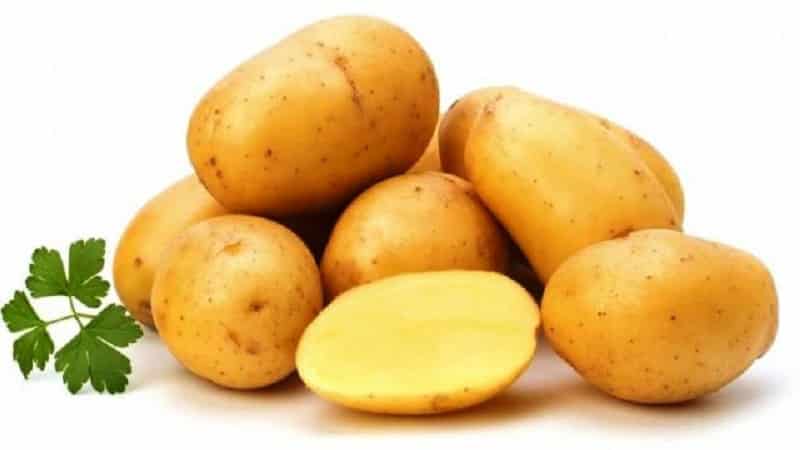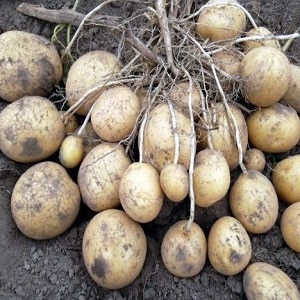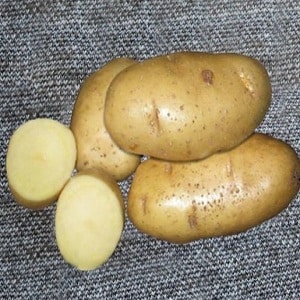The Lasunok potato variety, beloved by farmers for its ease of care and productivity
Lasunok potatoes are an old-timer on the domestic market, which has not lost its popularity to this day, despite the abundance of new, improved varieties. The tubers have a distinct potato taste and aroma and are widely used in cooking and food production. The variety is unpretentious in care and requires a minimum amount of mineral fertilizers.
In this article we will talk about the nuances of agricultural technology, its advantages and disadvantages, and measures to prevent viral and fungal diseases.
Origin and description of potato varieties
Lasunok (original name Lasunak - “delicacy” from Belarusian) is a late potato variety bred by breeders of the Scientific and Practical Center of the National Academy of Sciences of Belarus for Potato and Horticulture.
Culture was included in the State Register of Belarus and Russia in 1988. Since then, the variety has remained one of the most popular in both countries.
Patents for the sale of seeds are held by:
- FGBNU All-Russian Scientific Research Institute of Reclaimed Lands;
- FGOU VPO Tver State Agricultural Academy;
- Republican Unitary Enterprise Scientific and Practical Center of the National Academy of Sciences of Belarus for potato and fruit and vegetable growing;
- BRANCH OF FSBI "Rosselkhoztsentr" in the Nizhny Novgorod region.
The photo shows Lasunok potatoes.

The table shows the main characteristics of the culture.
| Indicators | Characteristic |
|---|---|
| Ripening period | 80–120 days |
| Bush | Erect, tall |
| Number of tubers in a bush | 10–12 |
| Weight | 150–200 g |
| Form | Round-oval |
| Coloring | The skin is light yellow, with medium-depth eyes, the flesh is creamy |
| Leaves | Medium size, emerald green, jagged edges |
| Corolla color | White |
| Starch content | 15–22% |
| Taste | Excellent (5 on a five-point scale) |
| Cooking class/group | C (dissolves strongly in water) |
| Productivity | On average - 400–450 c/ha, maximum - 620 c/ha |
| Marketability | 94% |
| Keeping quality | 95% |
| Purpose | Dining room, universal |
| Sustainability | Immunity to cancer, late blight of tubers, viruses S, M, U, L, average resistance to late blight of leaves, black and common scab, black leg, susceptibility to virus “X” |
| Transportability | High |
Agricultural technology of culture
The principles of growing Lasunka potatoes boil down to pre-germination, dividing the tubers into parts, moderate watering, loosening, hilling and monitoring nitrogen levels.
Dates, scheme and rules of planting
Lasunok is suitable for growing in almost any type of soil. It shows the best results on sandy soil, the worst on clay soil.
Heavy, clogged soil is loosened using river sand or sawdust. A month before planting, the area is sown with green manure (flax, wheat, rye, oats, lupine). Mown greens are embedded in the soil to increase fertility, oxygen saturation, and prevent the development of pathogenic microflora.
2-3 weeks before planting, the tubers are taken out of the basement and taken out into sunlight for germination. Deadlines landings depend on the region. In the southern regions, planting work begins in mid-April, in the middle zone - in early May. The air should warm up to at least + 15°C, the soil - to +7...+8°C.
The minimum germination temperature is +7°C.Tubers are soaked in a solution of potassium permanganate, copper sulfate or Fitosporin. The day before planting, the seeds are treated with germination stimulants “Epin” and “Zircon”.
Potatoes grow best in partial shade rather than full sun.. Holes are formed in the selected area, the depth of which depends on the type of soil:
- on loam - 5–7 cm;
- on sandy and sandy loam - 10–12 cm.
The distance between the holes is 35 cm, between the rows - 70 cm. A handful of wood ash and humus is added to each hole and a strong solution of potassium permanganate is poured.
Advice. To repel click beetle larvae, place onion skins in the holes.
Care
Rules for caring for plantings:
- The plant does not like stagnant water in the soil, but it does not tolerate drought. When there is a lack of moisture, the tubers grow small. The ideal solution for a large planting area is a drip irrigation system. In household plots, potatoes are watered for the first time a week after planting, and then once every 2 weeks.

- Loosening is carried out shallowly, after each watering, trying not to damage the root system.
- Weeding is a must for successful potato growing. Weeds are removed by the roots and completely removed from the site.
- Potatoes are hilled after the sprouts reach a height of 10 cm, and again during the flowering period. When cultivating on an industrial scale, harrowing is carried out using walk-behind tractors.
- Fertilizers are applied carefully, 10–15% less than the recommended dose, and the level of nitrogen in the soil is controlled. Its excess leads to an increase in green mass and a decrease in the size of tubers.
During this growing season, foliar mineral supplements with phosphorus, potassium, manganese, boron, and magnesium are actively applied:
- The first portion of fertilizers is 14 days after planting: 50 g of nitrophoska/10 l of water. Stimulants with amino acids “Poteytin” or “Megafol” are added to the solution.
- The second portion is added during the budding period: 20 g of superphosphate, 2 g of potassium sulfate, 2 g of ammonium nitrate, 0.1 g of copper sulfate/10 l of water.
- The bushes are irrigated for the third time two weeks after flowering: 5 g of boric acid and 2 g of potassium permanganate/10 l of water. Boron prevents the formation of voids in potatoes, and manganese improves the taste of the product.
Nuances of cultivation and possible difficulties
Features of growing the Lasunok variety:
- To prevent rainfall soil erosion, in some regions of Russia potatoes are planted on flat areas. The maximum permissible slope is 3°.
- On heavy clay and loamy soils with high humidity, ridge planting is used.
- In regions with arid climates, smooth planting is used in areas with sandy loam.
Advantages of ridge planting:
- improving soil aeration;
- rapid heating of the soil and early start of planting work;
- increasing productivity due to the free development of roots and tubers;
- increasing the productivity of agricultural machinery by 10–13%.
Autumn cutting of combs is used in the Central Black Earth region to obtain an early harvest. Work begins at the end of October, during the first frost. Ridges 25 cm high are formed on the site and humus is added at the same time. Row spacing is 70 cm.
Spring formation of ridges is practiced in the regions of the middle zone. First, the soil is loosened, then ridges 15–16 cm high are made. The distance between the rows is 70 cm.
Smooth planting of potatoes is a traditional method of planting tubers in holes “under a shovel”. They mark the beds on the site and use a bayonet shovel to raise a layer of earth 5–12 cm deep. It is more convenient to work together: one digs, the other spreads the seeds.
Interesting fact. The American company Naturally Best several years ago tried to popularize the exclusive Vivaldi potato variety. It was bred for its odor, reminiscent of fresh butter. Tubers contain 33% less calories compared to other potato varieties.
Diseases and pests
Variety Lasunok has immunity:
- to potato cancer;
- late blight on tubers;
- viruses S (leaf lightening), M (twisting, mosaic of the upper leaves), U (wrinkling, leaf striping), L (leaf curling along the central vein).
Potatoes are moderately resistant to leaf blight, black and common scab, blackleg, and are susceptible to virus X (yellowing of leaves, mosaic).
There is no treatment for viral diseases, and maximum damage is estimated 2 years after infection.
Virus control measures are aimed at preventing:
- use of healthy material;
- constant weeding of beds, removal of infected bushes;
- selection of seed tubers immediately after harvest;
- destruction of aphids, Colorado potato beetles, cicadas;
- culling tubers with weak and damaged seedlings;
- seed treatment with antiviral and antifungal agents;
- compliance with crop rotation.
Late blight appears as brown spots on the foliage and a white pubescent coating on the back side. The disease is most often detected during periods of prolonged rain. For treatment, use a 1% solution of Bordeaux mixture, “Silk”, “Krezacin”, “Bravo”, “Alufit”.
The originator claims that the variety is not afraid of the Colorado potato beetle.In fact, there is evidence that the pest happily eats the lush green foliage of the plant. During industrial cultivation, potato plantings are treated with fungicides “Prestige”, “Bankol”, “Konfidor”, “Commander”.
The following methods of beetle control are used in household plots:
- manual collection in a jar with saline or soap solution;
- dusting with gypsum, corn flour, birch ash;
- spraying plants with birch tar (100 ml/10 l of water);
- treatment with infusion of celandine (1.5 kg of fresh grass/10 l of water).
Collection, storage and use of crops
The harvest begins in September. After digging, the tubers are cleared of soil and sorted. Rotten tubers are thrown away, healthy ones are laid out in the shade and left to dry for 2-3 days.

Lasunok potatoes have a short dormant period and begin to germinate within 3–4 weeks when stored in inappropriate conditions. The optimal temperature in the basement is +1…+2°C. In such conditions, the potatoes remain until the next season.
For storage in the basement, wooden, plastic boxes, nets and burlap are used. Beets or apples are placed on top to prevent sprouting and rotting. The tubers are periodically sorted, completely removed from the container. Specimens with signs of rot, damage, greenness and sprouting are discarded.
In a city apartment, it is more difficult to preserve the harvest. Potatoes are placed on an insulated balcony or loggia in boxes mounted on a stand. Containers should not come into contact with the icy floor. This will protect the tubers from freezing.
Reference. There are special “balcony cellars” on sale that run on electricity. They are able to maintain optimal storage temperatures even in severe frost conditions (down to –40°C).
In cooking, Lasunok is used to prepare crumbly and aromatic purees, golden French fries, soups, stews, boiled and baked dishes. Large companies purchase potatoes for the production of fast food, snacks, starch and alcohol.
Advantages and disadvantages
Valuable qualities of the variety:
- high productivity;
- resistance to viral and bacterial diseases;
- universal use in cooking;
- ease of care;
- standard taste.
Among the disadvantages:
- the need to maintain temperature conditions during storage;
- obsolescence of the variety, tendency to degeneration.
Growing regions
The crop has received permission for cultivation in the following regions of Russia:
- Central;
- Central Black Earth;
- Volgo-Vyatka;
- North-West;
- North Caucasus.
Reviews
Lasunok is an old but proven variety. Gardeners value it for its amazing productivity, resistance to viruses and fungi, and classic potato taste.
Evgeniy, Kanash: “I have known the Lasunok variety for a long time. I like its pronounced taste and aroma. Its mashed potatoes are the best I've ever tasted. I read in reviews that potatoes are resistant to the Colorado potato beetle due to their thick, rough leaves. But in fact, pests gnaw at them no worse than others. But for me this is not a problem. If there are few beetles, I collect them by hand. In case of massive damage, I spray it with any of the preparations available in the store.”
Elena, Orel: “I bought seeds of the first reproduction. The taste of potatoes is excellent, five plus, superior to some boiled varieties.The yield is high, the plants sometimes suffer from late blight when the summer is rainy, but I treat the bushes with whey and iodine as often as possible, and the scale of the damage can be reduced.”
Read also:
What are the benefits of potato juice for hair?
An unpretentious but productive Labella red potato variety.
How dangerous are potatoes and can you get poisoned by them?
Conclusion
The late variety Lasunok was positively assessed by many gardeners for its high yield, resistance to viral and fungal diseases, excellent taste and aroma. The disadvantage of the crop is the need for low temperature when stored in the cellar (+1...+2°C), since when it rises to just +4°C, the tubers begin to germinate.
The variety's agricultural technology is simple, but requires compliance with the rules of watering, loosening, weeding and hilling. Preventive measures (crop rotation, pre-planting treatment of tubers, weed removal) contribute to a healthy and rich harvest.